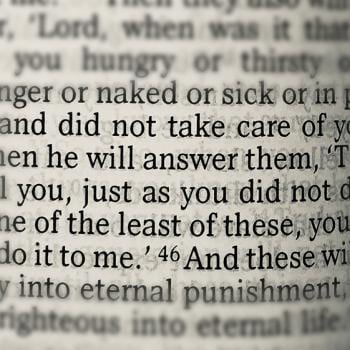Several weeks ago, in the aftermath of the bombing at the Boston Marathon, I wrote: “evil defies reason.” With the exposure now of kidnappings and years-long torture of three women in Cleveland, the time has come to further explore the nature of evil.
Again, evil defies reason. Reasonable people do not plant bombs that kill, maim and destroy. Reasonable people do not kidnap others and hold them and torture them for years on end. Reasonable people do not insist on sucking everyone around them into their own vortex of impenetrable darkness.
Reasonable people may make lots of foolish mistakes, even indeed bringing harm to others, but they do not do such things with hope-defying, life-destroying murderous intentions.
Evil people do exactly that.
It is the nature of evil to destroy innocence and to use fear and terror as primary weapons.
We often don’t know when we are going to come face to face with evil. There are no preparations adequate to protect from some of their plans—such as bombings. We can offer fairly effective protections from reasonable people when they make mistakes or engage in unwise activities, like mixing texting and driving or alcohol and loaded handguns. Such actions are not necessarily evil, despite the often destructive results.
But the craftiness of someone who has crossed over into evil often takes us by surprise.
Craftiness is such an important word here. The most evil are those who can make themselves look supremely good. The kidnapper in Cleveland offering rides, the religious practices that claim to own the only real path to redemption, the desire to consolidate power and special privilege by the justification that many will benefit—how often such ones are praised!
I’ve spent many pleasurable and also thought-provoking hours the last several weeks reading the Harry Potter novels by J.K. Rowling. I remember when they first came out and the initial movie hit the screens. Many well-meaning Christians called them “evil” and insisted they promoted witchcraft. Warnings popped up telling parents that their children should not read those books or see the movies.
What I’ve found is a compelling set of stories about the ongoing confrontations between good and evil. In Rowling’s character, Lord Voldemort, we have an exquisitely drawn portrait of the Evil One and his craftiness. But one set of beings that inhabit the Potter books seem to me to show most fully how that which is truly evil operates: these are the “dementors.”
As one of Harry Potter’s instructors described them: “Dementors are among the foulest creatures that walk this earth. They infest the darkest, filthiest places, they glory in decay and despair, they drain peace, hope, and happiness out of the air around them.”
Soullessness, emptiness, filth, decay and despair, disguised by false promises: these are the primary tools.
How shall we respond when face-to-face with such soul-sucking darkness? The human tendency? Fight bad with bad. “Well they hurt me, so I’ll hurt them in return” has justified more violence, war and destruction in the world than any other factor.
But when evil threatens us, we’d be much better off to change our focus from “How can I fight back” to “Why am I so destroyable?” Because when we are destroyable, we have let our own inner evil win rather than calling for the good also within us to stand firm.
Remember: Dementors, and even Lord Voldemort, eventually do face defeat. But they are defeated by good, not by greater evil.
We must discover the real nature and power of goodness in order to be both effectively protected and properly armed to engage evil with competence and hope. The craftiness of the Evil One has made that discovery process amazingly difficult.
I look forward to exploring these things with you over the next few weeks in both writing and preaching as I return to the pulpit on May 26.













